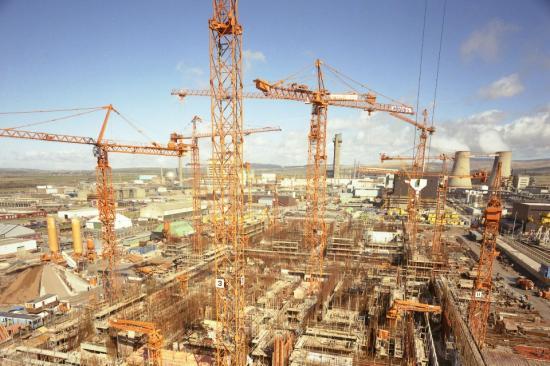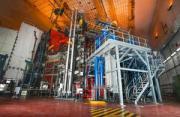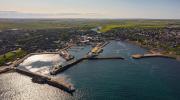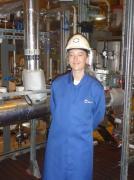What Is Thorp? - Thermal Oxide Reprocessing Plant
26th September 2024

Today, the ponds inside the Thermal Oxide Reprocessing Plant (or as we like to call it, Thorp) are used to store nuclear fuel that has been used in the UK's 7 operational nuclear reactors.
Before taking on this new mission, Thorp reprocessed 9,000 tonnes of used nuclear fuel from around the world, generating an estimated £9 billion in revenue for the UK over 2 decades.
The parts of the plant that were used to reprocess used fuel are called ‘chemical separation' and are currently going through a process called Post Operational Clean Out (POCO).
Thorp is helping to keep the UK's lights on
Even though it's original reprocessing mission came to an end in 2018, Thorp continues to key role in the UK's energy strategy.
Ponds inside the plant that were originally used to store spent oxide fuel before it was reprocessed have been modified so that they can store Advanced Gas-cooled Reactor (AGR) fuel.
By doing this Thorp:
Supports electricity generation in the UK
With limited interim storage at the AGR reactor sites, spent fuel is transferred to the Sellafield site. This is crucial in enabling continued nuclear reactor operation and electricity generation within the UK.
Supports with the bulk-defueling of AGR reactors
As the fleet of 7 UK AGR power stations start come to the end of their operational life, Thorp is also playing a key role in assisting with the bulk defueling (similar to refuelling a reactor but new fuel isn't put back in) of the reactors before they are decommissioned.
As of September 2024, 3 of the reactors (Hunterston B, Hinkley Point B and Dungeness B) have ceased generating and begun defueling.
All other reactors are expected to have completed their defueling operations by the early 2030s.
At this point there will no longer be new commercial nuclear fuel being received into the ponds.
Making changes to Thorp's receipt and storage ponds
Our teams have been working to make some changes and improvements to Thorp's receipt and storage pond so that used nuclear fuel can be stored safely for longer.
Storage
The Thorp receipt and storage ponds hold the same volume of water as 20 Olympic sized swimming pools. Although large, its storage capacity is finite.
The solution has been the development and deployment of a new design of fuel can storage racks. Because these new racks are taller but have a smaller footprint than the previous design, they can hold 6,000 tonnes of fuel each. That's more than 50% more fuel than the previous design.
Fuel that was already being stored in the pond is being transferred into the new storage racks and all future fuel receipts will be stored in this way.
Thorp's history
Thorp's story started back in the mid-1970s when a new fleet of nuclear reactors came online and used oxide fuels rather than Magnox fuel. Thorp was designed to reprocess this fuel after it had been used inside the reactors.
Planning and construction of Thorp (1974 to 1988)
1974 to 1978
For 100 days in 1977, a public inquiry - The Windscale Inquiry - looked at the implications of building Thorp.
1978
The government approved the construction of Thorp.
This new building at Sellafield would stretch over a third of mile, housing the facilities needed to reprocess oxide fuel under one roof.
1981
Site clearance and construction began. Thorp was one of the largest and most complex construction projects in Europe, rivalled only by the Channel Tunnel and Disneyland Paris.
1984
Major civil work began.
The construction project dominated the site, and the local area. Local towns and villages were filled with the thousands of construction workers required to make this one-stop shop a reality.
It was one of the biggest construction projects of its times and saw more than 5,000 people on site and a further 10,000 roles in the supply chain.
1988
The receipt and storage pond opened, taking receipt of the first batch of irradiated fuel.
The pond is the size of 20 Olympic swimming pools, at 73m long, 23m wide and 8m deep.
1993
Following a further major Government review of the viability of the project, Thorp was given permission to operate.
Thorp operations (1994 to 2018)
1994
Thorp reprocessing facility becomes operational with the first batch of fuel sheared.
Shearing is where nuclear fuel is cut into pieces at the beginning of the reprocessing cycle.
1997
Thorp is fully operational and has 34 customers in nine different countries.
2005
The plant temporarily closed due to pipe failure in the feed clarification cell.
2011
The Nuclear Decommissioning Authority started to consider the credible options for the future of Thorp, looking at safety, cost, technical and performance risks.
2012
7,000 tonnes of fuel have now been reprocessed.
The decision is made to close Thorp in 2018 when existing contracts have been completed.
2018
The last batch of fuel to be reprocessed began its journey through the plant at 11.32am on Friday 9 November.
Over its lifetime, Thorp reprocessed 9,000 tonnes of fuel from around the world, generating an estimated £9 billion in revenue for the UK during its lifetime.
For more links and photos go to
https://www.gov.uk/government/case-studies/what-is-thorp
Related Businesses
Related Articles
TAE Technologies and UKAEA partner to commercialise fusion tech
Joint venture to develop neutral beams for fusion and non-fusion applications, creating high-skilled jobs and establishing a critical supply chain. TAE Technologies, a leading US private fusion energy firm with over 25 years at the forefront of scientific innovation, today announces a bilateral and reciprocal investment commitment with the United Kingdom's national fusion laboratory, the UK Atomic Energy Authority (UKAEA) to commercialise TAE's proprietary particle accelerator technology for the global market.
Buried Hazards, Unfinished Business - What the NDA's 2025 Progress Report Really Tells Us
The Nuclear Decommissioning Authority (NDA) has released its 2025 Mission Progress Report is a slightly sprawling document chronicling one of the UK's most complex environmental undertakings. The safe dismantling of its early nuclear legacy.
New recruit officers join the Civil Nuclear Constabulary
The Civil Nuclear Constabulary (CNC) welcomes its newest recruits. The CNC hosted two passing out parades for the graduating Authorised Firearms Officers (AFOs) of Initial Foundation Programme (IFP) 106.
Dounreay's next generation of talent honoured by apprentice award
Nuclear Restoration Services Dounreay's Kate Thomson has won Modern Apprentice of the Year at the Highlands & Islands Apprenticeship Awards in Inverness. Kate, who is in the second year of her apprenticeship in commercial and quantity surveying, said she was thrilled by the honour.
Taskforce calls for radical reset of nuclear regulation in UK
Nuclear Regulatory Taskforce publishes final report and calls for radical reset of overly complex nuclear regulatory system. An overly complex nuclear regulatory system has contributed to the "relative decline" of the UK's ability to deliver faster and cheaper nuclear projects.
Funding approved for Wick Harbour port consultant
A specialist ports consultant has been appointed to develop a long-term strategic plan for Wick Harbour Authority (WHA) in Caithness. WHA has secured £47,775 from Highlands and Islands Enterprise (HIE) and the Nuclear Restoration Services, NRS Dounreay towards the cost of the services.
Fallon Campbell From Melvich Near Thurso Named As Apprentice of the Year At Awards In London
Rising star from North Scotland honoured at event to celebrate brightest and best in industry. An electrical apprentice from North Scotland is celebrating after being recognised for her contribution to industry at the 13th annual Engineering Construction Industry ECI Training and Development Awards in London.
The NDA Group Graduate Programme: more than a job
The NDA group graduate scheme offers far more than just a stepping stone into the nuclear industry; it's a chance to grow professionally, explore new places, and become part of a supportive community. Nuala Ledward, Assurance and Performance Graduate, shares how her secondment to Dounreay brought these benefits to life.
UKAEA develops 3D printing for fusion components
At its recently opened Central Support Facility (CSF), UKAEA has commissioned an electron beam additive manufacturing machine that can be used to incorporate tungsten into components, alongside a selective laser manufacturing machine. Fusion can play a key role in a global low carbon energy future.Advancing Fusion Remote Maintenance: Industry Collaboration Driving Innovation
As part of the Fusion Futures (FF) programme, UKAEA's Remote Applications in Challenging Environments (RACE) has partnered with industry leaders to develop two groundbreaking technologies for remote maintenance in fusion energy engineering. Thanks to FF funding, industry has taken the lead in maturing UKAEA technology concepts—delivering real-world solutions that enhance operational autonomy and reduce maintenance burdens in extreme environments.
